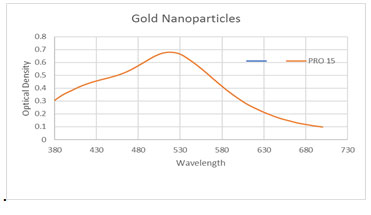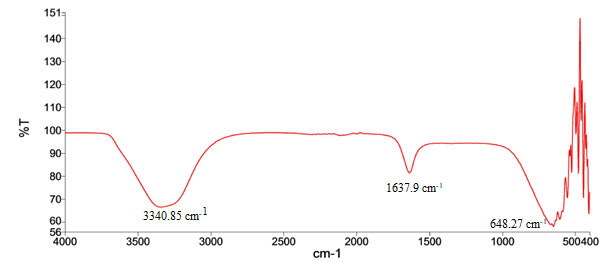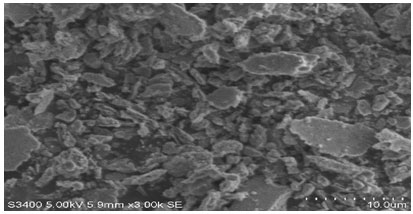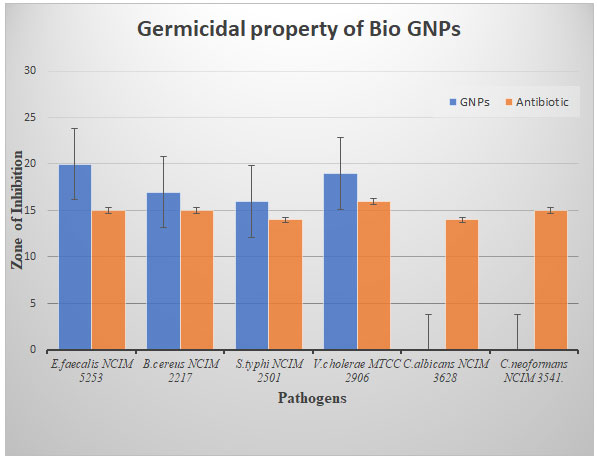Department of Studies and Research in Microbiology, Sahyadri
Science College, Kuvempu University, Shivamogga.
Corresponding author email: prashanth201821@gmail.com
Article Publishing History
Received: 01/07/2021
Accepted After Revision: 25/09/2021
Nanotechnology involves the utilization and creation of nanomaterials that range up to 1 to 100 nm in size. The synthesis of nanoparticles using biological roots involves the usage of bacteria, fungi, actinomycetes, algae, enzymes, and plants. These synthesized nanoparticles show various activities which are of medical importance (i.e., Antimicrobial, Anticancer, Antioxidant, etc.). In the present investigation, the synthesis, characterization, and application of Gold Nanoparticles (Bio-GNPs) Streptomyces sp.PRO-15 was reported. The Cell-free extract of Streptomyces isolate was used as the reducing agent for facile, cost-effective, and eco-friendly synthesis of GNPs. The synthesis of gold nanoparticles was carried out by treating 1mM Gold chloride (HAuCl4) solution with the Cell-free extract of Streptomyces isolate. Using UV-visible spectroscopy, the formation of GNPs was confirmed by measuring the peak ranging between 400-700 nm. The synthesized GNPs showed a sharp peak at 520 nm. The involvement of biomolecule in the stabilization of nanoparticles was confirmed with Fourier transform infrared spectroscopy (FTIR). The size of GNPs present in the colloidal solution was determined using Dynamic light scattering (DLS), with an average size ranging from 24. 97nm. The Zeta potential of GNPs was noted to be -23.2 mV. The shape of the nanoparticles was determined using Scanning Electron Microscope (SEM). The germicidal activity of the synthesized gold nanoparticles was tested against pathogens like Bacillus cereus NCIM 2217, Enterococcus faecalis NCIM 5253, Vibrio cholerae MTCC 2906, Salmonella typhi NCIM 2501, and Candida albicans NCIM 3628, Cryptococcus neoformans NCIM 3541, and consequently, it may be used as a potential germicide in the treatment of the infection caused by germs.
Actinomycetes, Biosynthesis, Bio-Gold Nanoparticles (Bio Gnps), Germicidal Activity.
Prashanth K. M, Onkarappa R. Germicidal properties of Biosynthesised Gold Nanoparticles from Streptomyces sp. Biosc.Biotech.Res.Comm. 2021;14(3).
Prashanth K. M, Onkarappa R. Germicidal properties of Biosynthesised Gold Nanoparticles from Streptomyces sp. Biosc.Biotech.Res.Comm. 2021;14(3). Available from: <a href=”https://bit.ly/3xUm7M4“https://bit.ly/3xUm7M4</a>
Copyright © Prashanth and Onkarappa This is an open access article distributed under the terms of the Creative Commons Attribution License (CC-BY) https://creativecommns.org/licenses/by/4.0/, which permits unrestricted use distribution and reproduction in any medium, provide the original author and source are credited.
INTRODUCTION
Nanotechnology is a field of science that is rapidly growing in current scientific research, which involves the production and usage of nanoscale materials for different purposes of human life, like energy storage, cosmetics, clothes, optical devices, bactericidal, biological labeling, biosensors, and treatment of cancer. The term nanotechnology was first used in 1974 by Norio Taniguchi of Tokyo Science University (Vadlapudi and Kaladhar 2014; Hasan 2015). Nanoparticles are materials with sizes ranging from 1 to 100nm (Hasan 2015). Nanoparticles have distinctive chemical and physical properties, and the nanoscale (1-100 nm) plays a crucial role in various aspects of pharmaceutical, medicine, and environmental technologies. Different physical and chemical methods are employed for the synthesis of nanoparticles with a particular size, shape (Natesan et al. 2020).
Physical method yields product with the complication of consuming high energy and generation of heat, chemical methods use the toxic chemical releasing hazardous chemicals as bi-products and are expensive (Babu et al. 2009; Natesan et al. 2020). To overcome this biological method of synthesizing nanoparticles provides a decent solution, which involves using microorganisms like bacteria, fungi, actinomycetes, enzymes, amino acids, and plants. The nanoparticles synthesized using biological roots are eco-friendly and cost-effective (Keshavamurthy and Rai 2021). Actinomycetes are Gram-positive aerobic filamentous bacteria with high GC content. They are Saprophytic and readily break down complex biopolymers. About 100 genera of Actinomycetes exist in soil and produce over 10,000 bioactive compounds, out of which 7600 are from Streptomyces genera (Salimath and Onkarappa 2016; Mesta and Onkarappa 2017).
These bioactive compounds are of high clinical importance and are applicable as germicidal, anti-parasite, antitumor, anti-viral agents, and other pharmaceutically beneficial compounds. Multidrug resistance of bacteria has become a significant threat to public health. The emerging drug resistance in bacteria and the increase in the production cost of new antimicrobial compounds to tackle them leads to the need for the development of new technology which is economically cheap and effective to combat Multidrug resistance bacteria (Al-Ansari et al. 2019).
Nanoparticles synthesized by microorganisms are among the best candidates for producing new antimicrobial material (Buszewski et al. 2018; Al-Ansari et al. 2019). The present study is focused on the biosynthesis of gold nanoparticles (GNPs) using the cell-free extract of Streptomyces sp. (PRO15) as stabilizing and reducing agent. The synthesized GNPs were characterized using UV-visible spectroscopy, FTIR, SEM, Dynamic light scattering, and Zeta Potential Analysis (Składanowsk et al. 2017; Hamed and Abdelftah 2019; Hamid et al. 2020). The present study also focused on the germicidal activity of synthesized GNPs against bacterial and fungal pathogens.
MATERIAL AND METHODS
The Streptomyces sp. (PRO15) was isolated from the coffee plantation soil of Kodagu Karnataka, India. The obtained pure strain was then streaked onto Starch Casein Nitrate (SCN) Agar slants and was stored at 40C for future use. Morphological studies were carried out using the coverslip technique. Grams staining and acid-fast staining were performed. Biochemical tests viz., Starch hydrolysis, Casein hydrolysis, gelatine hydrolysis Catalase test, H2S production test, and carbohydrate fermentation test were carried out (Aneja 1996; Cappuccino and Sherman 2014).
Following the methodology by Skladanowski et al. (2017), the synthesis of nanoparticles was carried out with slight modification. Streptomyces sp. (PRO 15) was inoculated into sterile SCN Broth and incubated at 30±2ºC on a closed rotary shaker at 150 rpm for 96hrs. After incubation, the broth was centrifuged at 7500 rpm for 15 min. The supernatant was collected, and 1mM gold chloride nitrate (HAuCl4_3H2O) was added at a ratio of 1:1 (V/V).
Sterile SCN broth and culture supernatant without HAuCl4 was kept as control. During incubation, the flasks were observed for the development of pinkish-purple color, which indicated the production of nanoparticles. Bioreduction of gold ions was recorded using a UV-Vis spectrophotometer. A small aliquot sample was taken in a quartz cuvette and observed for wavelength scanning between 380-800 nm. The UV-Vis spectrum of gold nanoparticles was obtained using an ELICO SL159 UV-Visible spectrophotometer (Shah et al. 2020).
Fourier transform infrared spectroscopy PerkinElmer FT-IR C94012 was used to detect the functional groups present on the synthesized gold nanoparticles. The colloidal gold nanoparticle solution was used for FT-IR measurements. The wavelength for spectral reading was recorded between 4000and 400cm-1 (Hamed and Abdelftah 2019; Shah et al. 2020). The powdered nanoparticle was placed on a carbon-coated plate.
Then the plate was gold-coated by a sputter-coating instrument to enhance the conductivity and accuracy of the picture. A scanning electron microscope (Hitachi, S-3400N, Japan) was used to analyze the morphology and size of the particles (Sadhasivam et al. 2012). Size distribution and Zeta potential of the synthesized Gold Nanoparticle were determined using Zetasizer Ver. 7.12 (MAL1169468 Malvern Instrument Ltd., UK) (Kulshrestha and Patel 2021).
The germicidal property of the synthesized nanoparticle was carried out by agar well diffusion method against Bacillus cereus NCIM 2217, Enterococcus faecalis NCIM 5253, Vibrio cholerae MTCC 2906, Salmonella typhi NCIM 2501, Candida albicans NCIM 3628, and Cryptococcus neoformans NCIM 3541. 24hrs old cultures of these pathogens were prepared in Luria-Bertani broth and were used for the test.
Muller Hinton Agar was inoculated with the pathogens, and 8mm wells were punched using a cork borer, and 100µl nanoparticle was pipetted into each well. Ampicillin and Nystatin were used as standard antibiotics for bacteria and fungi, respectively. Gold chloride was used as a control. After incubation at 370C, the radius of inhibition around the well was measured in mm (Hamed and Abdelftah 2019; Kulshrestha and Patel 2021).
RESULTS AND DISCUSSION
Isolation and Identification of Actinomycetes strain: A total of 36 isolates were obtained which were subjected for the biosynthesis of nanoparticles. Out of all, two isolates (Represented as strain PRO15 and PRO 16) showed promising results in the synthesis of gold nanoparticles. In the present investigation, one of the isolates (PRO15) was used for further studies.
The isolate was identified as Streptomyces sp. by referring to Bergey’s Manual of Determinative Bacteriology, Systematic bacteriology, and the International Streptomyces Project guidelines (Shirling and Gottlieb 1966; Holt et al. 2000; Hamed and Abdelftah 2019). The microscopic studies revealed the spore chain arrangement of the isolate was rectus. And the electron microscopic studies showed the spore surface ornamentation was smooth (Fig: 1).
Figure 1: (A) Actinomycetes isolate PRO15 (B) Spore chain arrangement of isolate Streptomyces sp. PRO15 (C) Scanning Electron Microscopy image of Streptomyces sp. PRO15.

The isolate was Gram-positive and non-acid-fast. Different biochemical tests were performed, and positive results were observed for catalase, starch hydrolysis, casein hydrolysis, gelatine hydrolysis. A negative result was observed for H2S production (Table 1). The carbohydrate fermentation studies showed alkali production in sucrose, fructose, maltose, and starch, acid Production in Dextrose, and No gas production was observed (Table 2).
Table 1. Morphological and biochemical characterization of Streptomyces sp. PRO 15
| Sl. No | Test | Result |
| 1 | Aerial mycelium | White |
| 2 | Substrate Mycelium | Cream |
| 3 | Diffusible pigment | None |
| 4 | Starch Hydrolysis | + |
| 5 | Gelatine Hydrolysis | + |
| 6 | Casein Hydrolysis | + |
| 7 | Catalase | + |
| 8 | H2S Production | − |
| 9 | Grams Staining | Gram-positive |
| 10 | Acid-Fast staining | Non-acid fast |
+: Positive, −: Negative
Table 2. Carbohydrate utilization Test of Streptomyces sp. PRO 15
| Isolate | Dextrose | Sucrose | Fructose | Maltose | Starch | ||||||||||
| PRO 15 | G | A | Al | G | A | Al | G | A | Al | G | A | Al | G | A | Al |
| – | + | – | – | – | + | – | – | + | – | – | + | – | – | + | |
*G: Gas, A: Acid, Al: Alkali
Synthesis and characterization of Bio-Gold nanoparticle: Actinomycetes are known to produce more than 10,000 bioactive metabolites (Berdy 2005). Only three of the actinomycetes genera viz. Streptomyces, Rhodococcus, Thermomonospora are the potent producers of nanoparticles (Ahamad et al. 2003; Sadhasivam et al. 2010; Ranjitha and Rai 2017). Applications of Nanoparticles have attained much importance in biomedical applications. But the development is still in its initial stage (Skladanowski et al. 2017; Hamed and Abdelftah 2019).
The change in the reaction mixture from yellow to pinkish-purple indicated the production of nanoparticles (Figure: 2). The difference in color in the reaction was due to the reduction of HAuCl4 and the surface plasmon resonance (SPRs) effect (Philip 2008; Manivasagan et al. 2013). Using the results of Skladanowski et al. (2017), the synthesis of GNPs by actinomycetes cell-free extract was confirmed. Synthesis of GNPs by different methods like biomass starving was also reported. The UV-Vis spectroscopy study revealed the absorbance peak of the Bio GNPs at 520nm (Figure: 3), which represented the formation of GNPs. The surface plasmon resonance (SPR) of GNPs ranges from 520 to 560nm.
The peak height indicated the concentration of GNPs, and the shift of the peak towards a higher wavelength indicated an increase in size. The free electrons present in the metal nanoparticles gave the SPR absorption band due to the combined vibration from the electrons of nanoparticles with the light wave (Noginov et al. 2007). FTIR spectroscopy was carried out to determine the biomolecules present on the nanoparticle, which were responsible for formation and stabilization.
The IR spectral readings of GNPs showed a strong band at 3340.85cm-1,1637.9 cm-1, and 648.27 cm-1. The peak that appeared at 3340 cm-1 showed Carbon -Hydrogen bond(=-C-H) stretching, representing the alkyne group. The band seen at 1637.9 cm-1 had characteristics of -C=C- stretching that represented the alkene group. The band seen at 648.27 cm-1 also represented C-I stretching represented halo compounds (Figure: 4). Sivalingam et al. (2012) and Tamuly et al. (2013) reported the presence of biomolecules on biosynthesized nanoparticles that act as capping agents and are responsible for stabilizing nanoparticles.
Figure 2: Biosynthesised gold nanoparticle from Streptomyces sp. PRO 15. (A) Reaction mixture before incubation (B) Reaction mixture after incubation

Figure 3: UV-Vis absorption of Bio GNPs synthesized from Streptomyces sp PRO15

Figure 4: FTIR spectra of Bio GNPs Synthesised from Streptomyces sp. PRO 15.

SEM analysis: The scanning electron images of synthesized Bio GNPs showed that the nanoparticles were irregular in shape. (Figure: 5). Similar results were reported by Sadhasivam et al. (2012).
Figure 5: Scanning electron microscopic imaging of Bio GNPs synthesized from Streptomyces sp. PRO 15.

Dynamic light scattering and Zeta Potential Analysis: Dynamic light scattering (DLS) was used to determine the partial size of GNPs present in the colloidal solution. The average size of GNPs synthesized using Streptomyces sp. PRO 15 was found to be 24.97 nm (Figure:6). The Zeta potential of the bio-GNPs was noted to be -23.2 mV (Figure: 7). Results indicated the stability and monodispersed of the synthesized GNPs in the colloidal solution.
Figure 6: Size distribution of GNPs synthesized from Streptomyces sp. PRO 15

Figure 7: Zeta potential distribution of GNPs synthesized from Streptomyces sp. PRO 15.

Gade et al. (2010) and Rai et al. (2015) reported that the Zeta potential analysis of Bio GNPs provides information about the stability of synthesized nanoparticles. Zeta potential valve closer to -30mV indicates the metal nanoparticles to be highly stable.
Germicidal effect: Germicidal effect of Bio-Gold nanoparticles synthesized from Streptomyces sp. PRO 15 is shown in Figure:8. Germicidal property of Bio-GNPs against microbial pathogens E. faecalis showed the highest inhibition zone of 20mm followed by V. cholerae 19mm, B. cereus 17mm, S. typhi 16mm. The synthesized Bio-GNPs showed no inhibition against fungal pathogens C. albicans and C. neoformans. Standard antibiotics Ampicillin and Nystatin showed a zone of inhibition around 14mm to 16mm. Similar results were found by GNPs synthesized from Streptomyces sp. against pathogenic microbes (Kumar et al. 2016; Składanowski et al. 2017; Hamed and Abdelftah 2019).
Figure 8: Germicidal property of Bio GNPS synthesized from Streptomyces sp. PRO 15

CONCLUSION
The findings of the present study highlight the use of Actinomycetes as a biological source to synthesize Gold Nanoparticles (GNPs). The study was focused on developing an effective, low-cost protocol for the production of GNPs. This method does not employ toxic agents during the process, making it environmentally friendly, and the GNPs can be used in clinical applications. This study also studied the effect of GNPs as a germicidal agent against microbial pathogens, which may lead to the development of a new strategy to tackle antimicrobial resistance.
ACKNOWLEDGEMENTS
This study was supported by the Department of Studies and Research in Microbiology, Sahyadri Science College, Kuvempu University, Shivamogga. Authors thank the department for providing adequate lab facilities for this research work.
Conflict of Interests: Authors declare no conflicts of interests to disclose.
REFERENCES
Ahmad, A., Senapati, S, Khan I et al. (2003) Extracellular Biosynthesis of Monodisperse Gold Nanoparticles by a Novel Extremophilic Actinomycete, Thermomonospora sp, Langmuir, 19, pp. 3550–3553.
Al-Ansari, M, Alkubaisi, N, Vijayaragavan, P et al. (2019) Antimicrobial potential of Streptomyces sp. to the Gram positive and Gram-negative pathogens, Journal of Infection and Public Health, 12, pp. 861–866.
Aneja, K. R. (1996) Experiments in Microbiology, Plant Pathology, Tissue culture and Mushroom cultivation, Wishwa Prakashan, (2), pp. 190–217.
Berdi, J. (2005) Bioactive Microbial Metabolites A Personal View, Journal of Antibiotics. Antibiotics, 58(1), pp. 1–26.
Buszewski, B, Plugaru, V. R., Pomastowski, P., et al. (2018) Antimicrobial activity of biosilver nanoparticles produced by a novel Streptacidiphilus durhamensis strain, Journal of Microbiology, Immunology and Infection, 51(1), pp. 45–54.
Cappuccino, J.G. and Sherman, N. (2014) Microbiology a Laboratory Manual, Pearson Education, Inc., (10), pp.153-215.
Gade, A., Ingle, A., Whiteley, et al. (2010) Mycogenic metal nanoparticles: Progress and applications, Biotechnology Letters, 32(5), pp. 593–600.
Babu, G. M. M. and Gunasekaran, P. (2009) Production and structural characterization of crystalline silver nanoparticles from Bacillus cereus isolate, Colloids and Surfaces B: Biointerfaces, 74(1), pp. 191–195.
Hamed, M. M. and Abdelftah, L. S. (2019) Biosynthesis of gold nanoparticles using marine streptomyces griseus isolate (M8) and evaluating its antimicrobial and anticancer activity, Egyptian Journal of Aquatic Biology and Fisheries, 23(1), pp. 173–184.
Hamid, M. E., Mahgoub, A., Babiker, A.J.O., et al. (2020) Isolation and identification of Streptomyces spp. From desert and savanna soils in Sudan, International Journal of Environmental Research and Public Health, 17(23), pp. 1–10.
Hasan, S. (2014) A Review on Nanoparticles: Their Synthesis and Types, Research Journal of Recent Sciences, 4(9), pp. 1–3.
Holt, J.G., Krieg, N.R., Sneath, P.H.A., et al. (2000) Bergey’s manual of determinative bacteriology, Lippincott Williams and Wilkins, (9), pp. 605-623.
Keshavamurthy M and Ravishankar Rai V. (2021) Green Synthesis, Characterization and Screening for Antibacterial Activity of Gold Nanoparticles Produced by Salacia fruticosa Leaf Extract, Bioscience Biotechnology Research Communications, 14(2), pp. 879–885.
Kulshrestha, A. K. and Patel, P. H. (2021) The Efficiency of Silver Nanoparticles Synthesized Using Streptomyces spp. against Human Pathogens, Bioscience Biotechnology Research Communications, 14(2), pp. 791–796.
Manivasagan, P., Venkatesan, J., Senthilkumar, K., et al. (2013) Biosynthesis, antimicrobial and cytotoxic effect of silver nanoparticles using a novel Nocardiopsis sp. MBRC-1, BioMed Research International, 2013. doi: 10.1155/2013/287638.
Mesta, S. C. and Onkarappa, R. (2017) Characterization and Antimicrobial Potential of Marine Actinomycetes From Estuaries of Uttara Kannada District, Karnataka, Journal of Drug Delivery and Therapeutics, 7(6), pp. 27–37.
Natesan, K., Ponmurugan, P., Gnanamangai, B.M., et al. (2020) Biosynthesis of silver nanoparticles from streptomyces spp., characterization and evaluating of its efficacy against Phomopsis theae and Poria hypolateria in tea plants (Camellia sinensis), Nano Biomedicine and Engineering, 12(3), pp. 272–280.
Noginov, M.A., Zhu, G., Bahoura, M., et al. (2007) The effect of gain and absorption on surface plasmons in metal nanoparticles, Applied Physics B: Lasers and Optics, 86(3), pp. 455–460.
Philip, D. (2008) Synthesis and spectroscopic characterization of gold nanoparticles, Spectrochimica Acta – Part A: Molecular and Biomolecular Spectroscopy, 71(1), pp. 80–85.
Shah, R., Vaghela, H., and Pathan, A., (2020) Synthesis and Characterization of Biogenic Gold Nanoparticles Using Aegle marmelos Extracts: Antibacterial Assay, Bioscience Biotechnology Research Communications, 13(1), pp. 307–312.
Rai, M., Ingle, A.P., Gaikwad, S., et al. (2016) Nanotechnology based anti-infectives to fight microbial intrusions, Journal of Applied Microbiology, 120(3), pp. 527–542.
Kumar, R.S., Narendhran, D.S., Kumar, S.P. et al. (2016) A Novel Streptomyces sp. Mediated Gold Nanoparticle Synthesis and Its Efficacy on Antibiogram and Cytotoxic Activity on Breast Cancer (MCF-7) Cell Line, Journal of Scientific Research, 11(3), pp. 183–188.
Ranjitha, V. R. and Rai, V. R. (2017) Actinomycetes mediated synthesis of gold nanoparticles from the culture supernatant of Streptomyces griseoruber with special reference to catalytic activity, 3 Biotech, 7(5), pp. 1–7.
Sadhasivam, S., Shanmugam, P. and Yun, K. S. (2010) Biosynthesis of silver nanoparticles by Streptomyces hygroscopicus and antimicrobial activity against medically important pathogenic microorganisms, Colloids and Surfaces B: Biointerfaces, 81(1), pp. 358–362.
Salimath MB and Onkarappa, R. (2016) Streptomyces MSR-V21, A Broad Spectrum Antibiotic Producing Antinomycetes Isolated from Shettyhalli Reserve Forest, Western Ghats of Karnataka, India, Research Journal of Agricultural Sciences, 7(2), pp. 245–249.
Shirling, E.B. and Gottlieb, D. (1966) Methods for characterization of Streptomyces species, International journal of systematic and evolutionary microbiology,16(3), pp.313-340.
Sivalingam, P., Antony, J.J., Siva, D., et al. (2012) Mangrove Streptomyces sp. BDUKAS10 as nanofactory for fabrication of bactericidal silver nanoparticles, Colloids and Surfaces B: Biointerfaces, 98, pp. 12–17.
Składanowski, M., Wypij, M., Laskowski, D., et al. (2017) Silver and gold nanoparticles synthesized from Streptomyces sp. isolated from acid forest soil with special reference to its antibacterial activity against pathogens, Journal of Cluster Science, 28(1), pp. 59–79.
Tamulya, C., Hazarika, M., Borah, SC., et al. (2013) In situ biosynthesis of Ag, Au and bimetallic nanoparticles using Piper pedicellatum C.DC: Green chemistry approach, Colloids and Surfaces B: Biointerfaces, 102, pp. 627–634.
Vadlapudi, V. and Kaladhar, D. S. V. G. K. (2014) Review: Green synthesis of silver and gold nanoparticles, Middle – East Journal of Scientific Research, 19(6), pp. 834–842.


